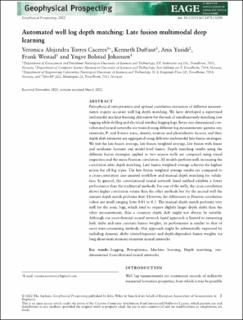| dc.contributor.author | Torres Caceres, Veronica Alejandra | |
| dc.contributor.author | Duffaut, Kenneth | |
| dc.contributor.author | Yazidi, Anis | |
| dc.contributor.author | Westad, Frank Ove | |
| dc.contributor.author | Johansen, Yngve Bolstad | |
| dc.date.accessioned | 2023-03-21T08:14:35Z | |
| dc.date.available | 2023-03-21T08:14:35Z | |
| dc.date.created | 2022-08-22T14:54:02Z | |
| dc.date.issued | 2022 | |
| dc.identifier.citation | Geophysical Prospecting. 2022, 1-28. | en_US |
| dc.identifier.issn | 0016-8025 | |
| dc.identifier.uri | https://hdl.handle.net/11250/3059422 | |
| dc.description.abstract | Petrophysical interpretation and optimal correlation extraction of different measurements require accurate well log depth matching. We have developed a supervised multimodal machine learning alternative for the task of simultaneously matching raw logging while drilling and electrical wireline logging logs. Seven one-dimensional convolutional neural networks are trained using different log measurements: gamma-ray, resistivity, P- and S-wave sonic, density, neutron and photoelectric factors, and their depth shift estimates are aggregated using different multimodal late fusion strategies. We test the late fusion average, late fusion weighted average, late fusion with linear and nonlinear learners and model-level fusion. Depth matching results using the different fusion strategies applied to two unseen wells are compared using visual inspection and the mean Pearson correlation. All models perform well, increasing the correlation after depth matching. Late fusion weighted average achieves the highest scores for all log types. The late fusion weighted average results are compared to a cross-correlation user-assisted workflow and manual depth matching for validation. In general, the convolutional neural network fused method exhibits a lower performance than the traditional methods. For one of the wells, the cross-correlation shows higher correlation values than the other methods but for the second well the manual depth match performs best. However, the differences in Pearson correlation values are small ranging from 0.01 to 0.1. The manual depth match performs very well for the sonic logs, which tend to require slightly larger depth shifts than the other measurements, thus a common depth shift might not always be suitable. Although our convolutional neural network fused approach is limited to estimating bulk shifts and uses constant fusion weights, its performance is similar to that of more time-consuming methods. Our approach might be substantially improved by including dynamic shifts (stretch/squeeze) and depth-dependent fusion weights via long-short-term memory recurrent neural networks. | en_US |
| dc.description.abstract | Automated well log depth matching: Late fusion multimodal deep learning | en_US |
| dc.language.iso | eng | en_US |
| dc.publisher | John Wiley & Sons Ltd on behalf of European Association of Geoscientists & Engineers. | en_US |
| dc.rights | Attribution-NonCommercial-NoDerivatives 4.0 Internasjonal | * |
| dc.rights.uri | http://creativecommons.org/licenses/by-nc-nd/4.0/deed.no | * |
| dc.subject | Maskinlæring | en_US |
| dc.subject | Machine learning | en_US |
| dc.subject | Petrofysikk | en_US |
| dc.subject | Petrophysics | en_US |
| dc.subject | Brønnlogging | en_US |
| dc.subject | Well Logging | en_US |
| dc.title | Automated well log depth matching: Late fusion multimodal deep learning | en_US |
| dc.title.alternative | Automated well log depth matching: Late fusion multimodal deep learning | en_US |
| dc.type | Peer reviewed | en_US |
| dc.type | Journal article | en_US |
| dc.description.version | publishedVersion | en_US |
| dc.subject.nsi | VDP::Petroleumsgeologi og -geofysikk: 464 | en_US |
| dc.subject.nsi | VDP::Petroleum geology and geophysics: 464 | en_US |
| dc.source.pagenumber | 1-28 | en_US |
| dc.source.journal | Geophysical Prospecting | en_US |
| dc.identifier.doi | 10.1111/1365-2478.13200 | |
| dc.identifier.cristin | 2045017 | |
| dc.relation.project | Aker BP: BRU21 – NTNU Research and Innovation Program at IGP | en_US |
| cristin.ispublished | true | |
| cristin.fulltext | original | |
| cristin.qualitycode | 1 | |

